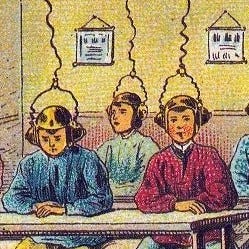I highly recommend Apple TV’s latest sci-fi series Silo - it’s good enough on its own to justify signing up for the service for a month. The first season covers approximately the first half of the first book (Wool) of Hugh Howey’s trilogy, which I thoroughly enjoyed reading several years ago. In this case, I think I would recommend breaking from tradition and watching the series before reading the book - the 10-episode TV adaptation has a slow-burn-mystery structure that’s probably more fun going in blind (though you can safely read this).
The series offers a deep exploration of a Discipline archetypal future scenario, specifically the totalitarian sustainable flavor. 10,000 individuals live in a 144-level underground silo in the aftermath of a disaster that leaves the Earth’s surface uninhabitable. Because they can no longer count on the Earth to provide life-sustaining ecosystem services such as clean air and water (or even sunlight), they have to provide all these things themselves, down to the electricity to light the farms growing their food. This has multiple implications, most notably that overall consumption has to be kept stable (both the population over time and the standard of living), and that means that a central authority has to control not only the provision of life-support functions but also reproduction (via implanted birth control and a lottery system) and technical innovation (via legal prohibition). Essentially, these people are kept alive year by year by depriving them of access to their past and future. However, the logical downstream implications of this are also worked through and on display at the micro level, with a strong ethic of recycling and reuse, a strong and formal apprenticeship/shadowing system instead of college, etc.
The fear of technical or social breakdown leading to annihilation permeates this society. A system with so many failure points means that most people have the sense that their work is the most important - Mechanical keeping the generator running, IT using the power to run the various systems, the mayor providing leadership to maintain harmony; there is a social hierarchy1 but no real underclass. The system and lessons on display here are broadly analogous to how I expect a remote space settlement, with infrequent or non-existent re-supply, might operate2; this alone was worth the price of admission for me.
As part of keeping society stable, lots of interconnected policies and systems need to be in place: radio communication is reserved for law enforcement, and most messages are sent via scraps of paper carried by porters up and down the stairs; mechanized transport can’t be developed, so the stairs serve as a natural barrier to too much travel and intermingling; relics from before the Silo was built are contraband, and speculating about what the world was like is taboo or worse; devices with certain capabilities (such as magnification above a threshold) are forbidden3. These systems are possible because of the central control over information afforded by centralized systems of power and the lack of ability for people to “vote with their feet” and leave the community in search of a better life.
One of the things I found most endearing about Silo was that, despite the mystery/thriller storyline and the work needed to maintain survival, there are lots of depictions of everyday life, joy, and community; the Silo doesn’t feel like a prison. This is an important element of futures studies that’s often missing from grim images of the future: people are great at adapting and will work to make the best of almost any circumstance. In this case, a long-term settlement of 10,000 people would probably function much like a small town4, and that’s portrayed in the public offices (mayor, sheriff and deputies, etc), in the way people know each other and are involved in each other's lives, in the public events and holidays5, and in the way religion and shared values bring the inhabitants together6.
Naturally, approximately based on how deep you live.
If you’re interested in more thinking about what future space settlements might be like, you’re in luck! I wrote all about this in June.
The challenge of restricting things based on what they can do, even though all the constituent parts are legal, reminds me of the problem of banning 3D-printed guns: can we effectively make owning or distributing the instructions illegal, or the manufacture of the guns, or the possession, etc?
Wow, what a rabbit hole looking for the official size of a “small town” on the internet can be, with every state and many federal agencies having its own definition. Different sites confidently claim that the US Census defines a small town as small as under 5,000 or as big as 25-50K residents.
Episode 5 features an event that most people would consider within a week of living in a silo like this - a race up all 144 flights of stairs.
Due to their circumstances and the degree of social engineering, their religion is very practical. Its main tenets seem to be an acceptance of the circle of life (in line with the recycling theme) and instilling deep fear about what lies outside the Silo.



